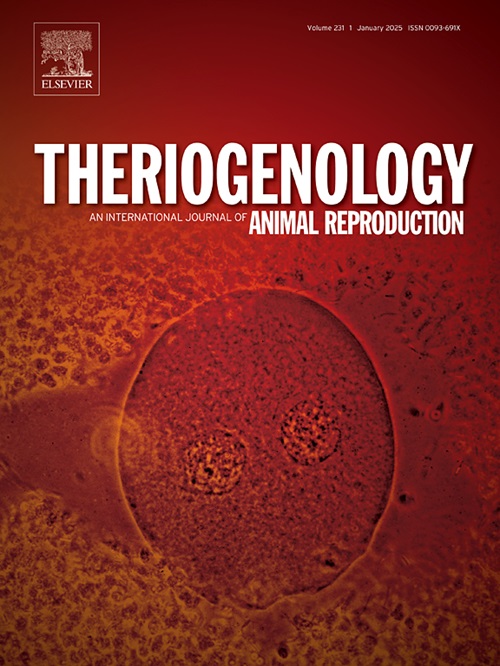Cryopreservation of sturgeon egg mitochondria and their replacement in germline: A novel strategy for maternal genetic preservation in sturgeons
IF 2.4
2区 农林科学
Q3 REPRODUCTIVE BIOLOGY
引用次数: 0
Abstract
Nearly all sturgeon species are critically endangered, necessitating the development of innovative approaches to preserve their genetic diversity and support population recovery. Unlike sperm, the cryopreservation of fish eggs or embryos remains technically unscalable because of the inherent structural and compositional barriers. Mitochondria are abundant in germ plasm and indispensable in the formation of primordial germ cells (PGCs). Transplanting isolated mitochondria into the vegetal pole of sturgeon embryos, where germ plasm is located, represents a promising conservation strategy. The transplanted mitochondria integrate into the germ plasm and are subsequently incorporated into the germline. Considering seasonality and long generation intervals of sturgeon reproduction, a reliable method for long-term storage of sturgeon egg mitochondria would be advantageous. This study optimized the cryopreservation of sturgeon egg-derived mitochondria, with subsequent validation of mitochondria structural and functional integrity. Various concentrations of dimethyl sulfoxide (DMSO), glycerol, and bovine serum albumin (BSA), combined with different freezing protocols were tested. Mitochondria functionality was assessed through four keys indicators: adenosine triphosphate synthesis, reactive oxygen species production, mitochondrial membrane potential, and integrity. For the first time, we demonstrated that sturgeon egg mitochondria can be successfully cryopreserved, recovered using transplantation and incorporated into the germline. Therefore, we restored maternal germplasm in sturgeon embryos. This work establishes a vital technological advance for conservation biology, offering an alternative approach to preserving and restoring maternal genetic information, which is currently unachievable through other methods in fish. Future research can leverage mitochondrial applications to advance germline preservation, surrogate reproduction, fertility enhancement, and reproductive biotechnology in aquaculture species.
鲟鱼卵线粒体的低温保存及其生殖系替代:鲟鱼母系遗传保存的新策略
几乎所有的鲟鱼物种都是极度濒危的,需要发展创新的方法来保护它们的遗传多样性并支持种群恢复。与精子不同,由于固有的结构和成分障碍,鱼卵或胚胎的低温保存在技术上仍然无法扩展。线粒体在胚质中含量丰富,是原始生殖细胞(PGCs)形成过程中不可或缺的组成部分。将分离的线粒体移植到鲟鱼胚胎的植物极,即种质所在的地方,是一种有希望的保护策略。移植的线粒体整合到胚质中,随后整合到种系中。考虑到鲟鱼繁殖的季节性和较长的世代间隔,一种可靠的长期储存鲟鱼卵线粒体的方法将是有利的。本研究优化了鲟鱼卵来源的线粒体的低温保存,并随后验证了线粒体的结构和功能完整性。不同浓度的二甲亚砜(DMSO)、甘油和牛血清白蛋白(BSA)结合不同的冷冻方案进行了测试。线粒体功能通过四个关键指标进行评估:三磷酸腺苷合成、活性氧产生、线粒体膜电位和完整性。我们首次证明了鲟鱼卵线粒体可以成功地冷冻保存,通过移植恢复并纳入种系。因此,我们在鲟鱼胚胎中恢复了母质。这项工作为保护生物学建立了一个重要的技术进步,提供了一种保存和恢复母体遗传信息的替代方法,这是目前通过其他方法在鱼类中无法实现的。未来的研究可以利用线粒体应用来推进水产养殖物种的种系保存、代生殖、生育力增强和生殖生物技术。
本文章由计算机程序翻译,如有差异,请以英文原文为准。
求助全文
约1分钟内获得全文
求助全文
来源期刊

Theriogenology
农林科学-生殖生物学
CiteScore
5.50
自引率
14.30%
发文量
387
审稿时长
72 days
期刊介绍:
Theriogenology provides an international forum for researchers, clinicians, and industry professionals in animal reproductive biology. This acclaimed journal publishes articles on a wide range of topics in reproductive and developmental biology, of domestic mammal, avian, and aquatic species as well as wild species which are the object of veterinary care in research or conservation programs.
 求助内容:
求助内容: 应助结果提醒方式:
应助结果提醒方式:


